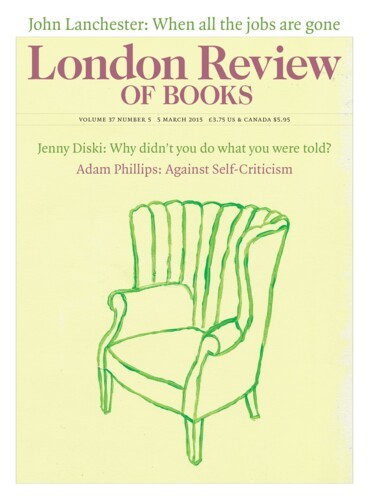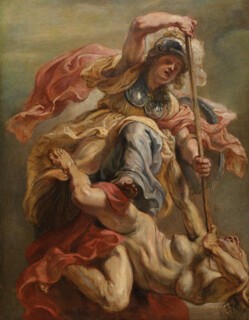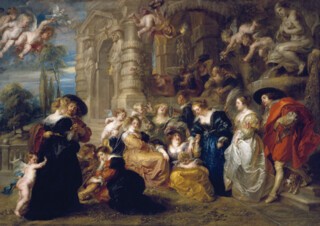The apple hadn’t yet fallen on Newton when Rubens died in 1640. Bodies might have weight, but gravity made a local rather than a comprehensive claim on them. Minerva’s heel thrusts down on the hip of Sedition in a sketch for the Whitehall Banqueting House ceiling Rubens painted in the 1630s, but the hag she seeks to pitch into the depths has no means of support: won’t they tumble together, as if into the Reichenbach Falls? And yet the picture makes a plausible claim on our physical intuitions. To flex one’s arms is to feel strength stemming from within: the armed defender of the state and her naked foe push against each other in this way, twin sources of energy interlocked.
Everything in this art wells out from bodies – as Kerry Downes noted in his 1980 study of Rubens, ‘space in his paintings exists between and because of objects and not independently of them’ – but bodies themselves begin as knots of force. Force acquires flesh, drapery, coloration, gleam: force is liable to fold in on itself and grow heavy. The profusion of works put out by the Antwerp studio showed all stages of the process. Looking up to his brother’s tutor, the neo-Stoic Justus Lipsius, and surely also to Leonardo, Rubens steered his operation according to philosophy, if not quite by science as we know it. A comprehensive idea of movement committed him to being interested in every sort of phenomenon, while the buoyancy of his own self-belief meant that the investigations seldom lapsed into mere principle. Like Leonardo, he thought about morphologies: the way carnivore bodies variegate, for example, in the Tiger, Lion and Leopard Hunt from the Musée des beaux-arts in Rennes, one of two big centrepieces in the current Royal Academy exhibition, Rubens and His Legacy: Van Dyck to Cézanne (until 10 April). Equally, he thought about the ways the human frame may veer into deformation (Sedition as hag) or rise into personhood. Coming at things this way, Rubens is hardly a portraitist in the sense his pupil Van Dyck is. Whereas you feel the latter is reacting to some grande dame’s jitters, Rubens homes in on what he conceives as his subject’s significance as an archetype: he presents a shining vessel of high femininity, no more than lightly dusted with accidents of character.
Pieter Bruegel, Rubens’s predecessor as painter-philosopher in Antwerp, is acknowledged several times in the Royal Academy’s exhibits. A gravely thoughtful landscape from the Hermitage known as The Carters interprets Bruegel’s reflections on the nature of human activity on the world’s surface in terms of geology: as if the energies needed to heave a load along a rutted road and those running through the rock strata are in essence the same. Bodies may come first in the panorama, but space gathers and lyrically expands around them. Elsewhere, Rubens covers both sides of a sheet with observations and then memories of peasants ripping it up at a kermesse. In the scribbled afterthoughts on the recto, you can see how Rubens rotates the dancing figures, conceiving them from all angles – the same knack that allowed him to fill the Banqueting House ceiling anti-gravitationally. He has at once the widest of art educations, the largest of ambitions and the visualising facility of a cartoonist: you are in the presence of a very formidable mind.
And that in itself contributes to the present-day viewer’s disjuncture – call it alienation, call it awe. Dislike is only too easy. There is the way Rubens systematically works the cues for so many emotions – for fear, fury, pathos, lust – without seeming to have a personal investment in any of them: the Tiger, Lion and Leopard Hunt with its gratuitous cleverness is a case in point. In this cocksure man of the world, any sense of humour is faint. Perhaps a naughty hermit sliding the sheets off a luscious sleeper was Rubens’s idea of a jape, but the studiousness of the execution ensures the actual painting is smile-free. There is also the unbridgeable distance separating us from the absolutist politics of his allegories, and more generally, the latent claustrophobia of a world depicted without gaps, a springy but sealed totality. It is as if you were in the belly of a great beast.
The beast is nonetheless astonishing, and it would be good to know where its heart lies. The Garden of Love from the Prado, the exhibition’s other big loan, looks very distant indeed from modernity. Apparently the costumes worn by its large cast of the amorous and the nubile reflect posh taste in the Antwerp of the early 1630s. Throughout those years, as Rubens worked on the near-three-metre composition, the armies of the renegade Protestant Dutch were often little more than a day’s ride from the city, rampaging through Catholic villages with the capture of Antwerp among their war aims. Ever since 1618, when the propagandist of divine right turned 41, Europe had been locked in intractable ideological bloodshed. The allegory for the Stuart monarch was upside down: it was Sedition who was pushing down Minerva, the goddess of state wisdom, with no bottom to the abyss in sight.
The canvas, you might argue, was equally upside down. While Jacques Callot’s Les Grandes Misères de la guerre, his contemporaneous print series, looked the massacres in the eye, Rubens turned the other way, seeking out a vision of the fruitful and sweet. That would be one explanation for the uncommissioned canvas’s outstanding intensity. The complexity of its mise-en-scène gave room for the whole breadth of Rubens’s transitions – from muscular twist to lush corporeality, from soft earth-colour groundwork to crescendos of vermilion, gold and azure – to fan out in the most thoughtful of studio meditations. Even while the painting is about touch, emergence and growth, it stands as something elegiac and implicitly mortal.
Nostalgia, then, may be inbuilt in the work of Rubens’s late middle age. And although Watteau, painting eighty years later, couldn’t have seen The Garden of Love itself (it had gone off to Madrid), his little Pleasures of the Ball from Dulwich is imbued with a spiritual affinity, similarly languorous and baklava-rich. At all events, the robust Fleming and the nervy Walloon share a room well: they make a natural fit in a show meant to acquaint us not only with Rubens, but with his afterlife in visual culture. It’s obviously right also to represent Delacroix, with his rapt nostalgia for other aspects of the Rubens oeuvre – the hunts and altarpieces, the spectaculars of rage and pity. In contrast to his cool-minded hero, Delacroix seems to chase emotion for emotion’s sake, pushing himself into desperate pictorial corners. As of the 1850s in Paris, the declaration that Rubens epitomised a ‘lost tradition’ had become structural and self-fulfilling.
There are welcome surprises in the survey. In 1803 James Ward, best-known for the Tate’s Gordale Scar, painted a stormswept Welsh landscape with bulls fighting that carried forward the spirit of The Carters into the Romantic era. It is good too to meet painters who looked at Rubens at a time when the tradition was alive and unself-consciously healthy: a grand dynastic-devotional canvas by Claudio Coello, who worked in Madrid in the wake of Velázquez and who has hitherto hardly been seen in London, is one of the thrills of the show. Then there were the specialists who latched on to particular elements: Thomas Lawrence, for instance, with the surefire colour construction of his portraiture.
But all this is to pick out a track across very rough ground. The exhibition must have been difficult to mount. Your research will have opened up countless promising trails, since Rubens was such a landmark for European painters who came after. But many loans elude you, and worst of all, too many crucial pieces by the protagonist won’t come through – not even the Chapeau de paille or Het Steen from the National Gallery just down the road, let alone any adequate representative of Rubens’s propagandist dynastic extravaganzas. You resign yourself to scrabbling instead for 17th-century prints and studies-after, weightless stand-bys for all that viscous oil and earth colour.
Thus a make-do assortment of Rubensiana gets matched up with trophies from the pursuit, anything from a Chinese pottery painter’s transcription of a Rubens crucifixion to a feeble early Klimt. An implausible gallery of modernist and postmodernist pieces, supposedly communing with a master whose authority had finally expired, only serves to emphasise that too large a table – the Academy’s main suite – has been spread with too thin fare. Bad luck for the curators, but bad judgment, too. Yes, on paper you can trace the way Rubens mattered to Rembrandt or to Reynolds, to Constable or to Cézanne: but put their pictures in the same room as his, and what you end up with – mark by mark, mentality by mentality – is a jangly discord. Sometimes you need to listen to your eyes.
Send Letters To:
The Editor
London Review of Books,
28 Little Russell Street
London, WC1A 2HN
letters@lrb.co.uk
Please include name, address, and a telephone number.



